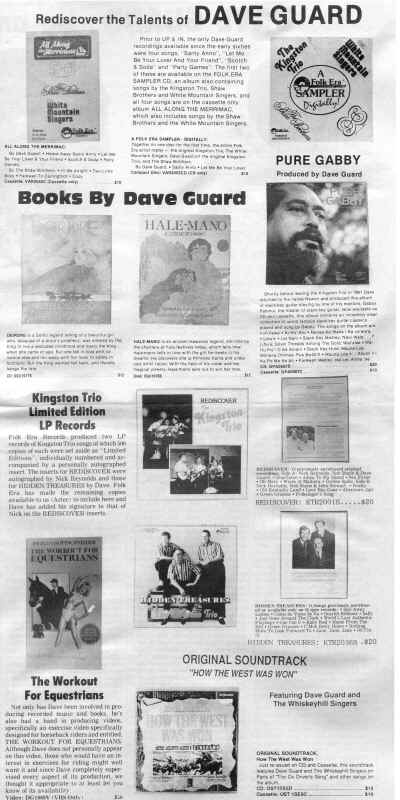
Page 27
POPULAR FOLK MUSIC TODAY, SPRING 1991
transmute immediately into a horn, become a human voice, then finally depart with the echo of Venusian harpstrings. On one song we start off blowing a conch shell, then bend the pitch of the note downwards as if it were produced on a slide trombone.
With all these choices to be made it was still our paramount goal to sound like real folk musicians playing real folk music. As a matter of fact, we were attempting to restore some of the authenticity that is lost when a "folk group" interprets music using its own resources. The Weavers sang Leadbelly tunes but never sounded like Leadbelly; The Beach Boys doing "The Sloop John B." sounded only like the Beach Boys; Peter, Paul and Mary wouldn't even pretend to be The Reverend Gary Davis singing "Samson and Delilah". With UP & IN it was different: we would try to sound like twelve different bands for the twelve different songs because we were not restricted by the number of instruments we could afford to take with us on the road. Of course the end result was bound to fall short of this ideal because I was the lead singer on all the tunes, and nobody in this world can sing like everybody else.
When all our material was assembled we gave it a good critical listen and decided that all those synthesizers by themselves sounded like plastic robots. This was the time to invite in some real human beings to supply some breath, perspiration and hormones in addition to the experiential expertise of a lifelong ability to make people get up and dance. Principal contributors to this cause were Steve Holley, who had drummed with Paul McCartney's band "Wings" for five years, and Jim Gregory, currently playing electric bass with the Manhattan group "Loup Garou" which features Creole Zydeco music. With these men up front and the synthesizers as background, our believability factor was greatly improved. My daughter Catherine flew over from L.A. to supply that perfect vocal blend, and about a dozen more great singers and players each contributed some unique and crucial element: for instance, Tommy Makem's tin whistle transformed one of the tunes from nice music to pure magic.
With every incoming musician I pursued the same policy that had worked for Amanda in the early stages: treat each song as if it were the soundtrack of a separate movie, with all the characters, scenery, plot and dialog .extensively specified. Each performer became one of the actors in the movie. I remembered my days as a studio musician in Australia, and what I would do in those situations was search my memory for fancy riffs I'd worked out previously, or try to apply some technique I'd learned from a music book, because the record producer would have requested a sixteen-bar solo that ended with a D7th chord, for example. I wanted to avoid that approach on UP & IN, since the musical requirements had already been fulfilled and we were looking for real people.
About my own performance: this is the first time the listener gets to hear my voice in its true register for any length of time. My other records were with groups where most of the time the job was to sing bass, or on special occasions stratospheric tenor, so even when my opportunity came for a straight solo there were remnants of tension. Now that thirty years have gone by, every tune is set not simply in my favorite key and tempo but in the only feasible key and tempo. Plus, the arrangements are such that the other notes steer out of the way of the lead vocal: you couldn't always rig the game that way when sharing the spotlight with partners from Big Time Showbiz. You'd be singing along then somebody would lean in and bark, "Hey, yeah! Tell it like it is, Captain Marvel!" or something similarly distracting.
Well, we filled up all 24 tracks on each of the twelve songs and got as far with the mixing process as any of us could endure by August of 1988. (It's possible to mix and remix the sounds on a tape until the Big Bang whimpers.) I had a bunch of casset tes made, and it wasn't too long afterward that Allan Shaw called me and asked if he could offer them through the Kingston Korner Katalog. And soon enough another gentleman from Illinois named Rod Mcknew asked Allan Shaw if I would be interested in having this album come out in the form of a Compact Disc. Interested and delighted, that's me.
Click image to download enlarged view (240 KB)
| Page 8 | Page 9 | Page 10 | Page 11 | Page 12 | |
| Page 13 | Page 14 | Page 15 | Page 16 | Page 17 | Page 18 |
| Page 19 | Page 20 | Page 21 | Page 22 | Page 27 | Page 28 |
|
|